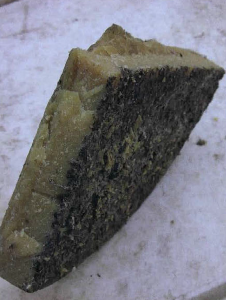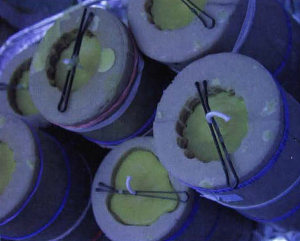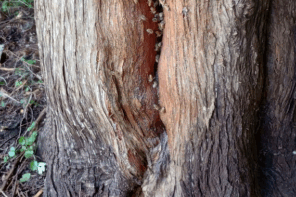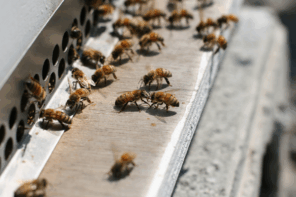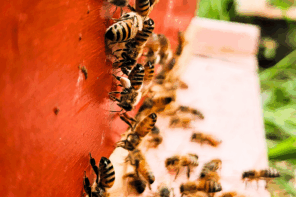By: Ross Conrad
This article originally appeared in the Spring 2017 issue of BEEKeeping Your First Three Years
Candle Making
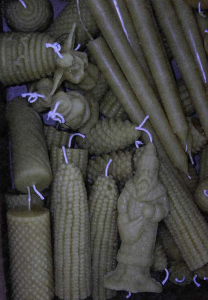 When thinking of products from the hive, most people will think of honey. Honey, however is simply a by-product of pollination, the most valuable and abundant product that honey bees provide. Beeswax, while not produced as abundantly as honey, is a byproduct of liquid honey production and is a valuable commodity which should not be wasted.
When thinking of products from the hive, most people will think of honey. Honey, however is simply a by-product of pollination, the most valuable and abundant product that honey bees provide. Beeswax, while not produced as abundantly as honey, is a byproduct of liquid honey production and is a valuable commodity which should not be wasted.
One of the most common uses for beeswax is to make candles. Beeswax candles are superior candles in that they burn longer and cleaner than other waxes (paraffin and soy). In this article we will explore the process and some considerations that should be taken in to account when making beeswax candles from the beeswax your bees produce.
Clean Wax
The most important thing you will need to make beeswax candles is clean beeswax. Any foreign debris in the wax (honey, propolis or pollen, etc.) will prevent candles from burning properly. The easiest thing to do is purchase filtered beeswax that is clean and ready to go. If you are planning on using hive scrapings, broken combs and cappings wax left over from the honey harvest, you will need to clean the wax first.
Cleaning beeswax is a two-step process. First the wax must be melted down in water. This facilitates the removal of the water soluble contaminants in the wax. The wax is then allowed to cool and harden, the water at the bottom of the pot (now muddy with dirt, honey and who knows what) is disposed of and the majority of the non-water soluble contaminants will have floated to the top of the water and become imbedded in the bottom of the hardened wax block. This dirt and debris should be scraped off with a hive tool and the remaining wax block be allowed to dry, before moving to the next step, which is re-melting the wax so that it can be poured through a filtering material in order to remove the remaining impurities. While some folks may use a paint filter, or some other filter for this job, I prefer to recycle my old clothing and use sweatshirt material, fuzzy side up as a filter, both because I think recycling is a good thing but also because I find sweatshirt material works better than paper paint filters. Paper towels, too work well and make excellent fire starters when done.
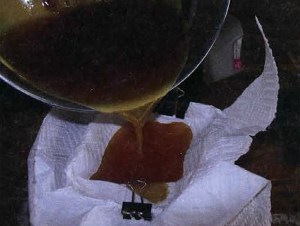
Melt the wax again and use a filter to remove impurities. I like sweatshirt material, but paper towels work too.
Do not try to rush the process and skip the first step, since any honey that is mixed in with your wax will easily pass through a filter and the resulting candles will spit and sputter and not burn well at all. Once you have good clean wax, you’re ready for the next step.
Selecting A Proper Wick
A properly wicked candle burns cleanly without carbon buildup, evenly without flicker, gives a reliable burn time and, for scented candles, will throw fragrance well. When a candle is under-wicked, meaning the wick diameter is too small for the candle, it will not melt the wax out to the edge of the candle and will instead burn down the middle or ‘tunnel.’ An under-wicked candle is likely to extinguish itself before all the wax is burned.
When the diameter of a candle wick is too large for the candle, the flame will be too tall and will flicker continually. An over-wicked candle will produce excess carbon as it burns, create a mushroom effect at the tip of the wick, and allow pieces of carbon to fall off into the pool of melted wax at the base of the burning wick. Over-wicked candles will produce wisps of soot or smoke from the flame periodically and will not burn as long as correctly-wicked candles.
While most candle making suppliers will provide recommendations when it comes to candle wick sizing, there are many variables that factor into matching a candle with the proper wick such as wax type, fragrance load, dye type, mold or container diameter, etc . . . As with any process, when manufacturing your candles, it is a good idea to always test burn a candle or two to ensure proper wick selection.
When various size candles are being made and numerous types of wick are required, consider labeling the rolls of wick so that they can be easily identified and used for the appropriate candle type.
No matter what size wick you use, I suggest that you consider only using pure cotton wicking. While zinc core wicks are the most commonly used wick type for many kinds of candles (it saves time as it allows for a wick that stands straight when pouring the wax), it may not be the best choice overall. The zinc core inside the wick will slowly burn and release zinc particle into the air. Reports of heavy metal toxicity from people who spend a lot of time around burning candles suggest caution should be taken when choosing a wick type.
The one exception to using 100 percent cotton wicks is when making a candle that sits in a large container. For such a candle, a paper core wick is called for as they burn very hot, and yield a large melt pool appropriate for a large container candle.
Be Sure To Lubricate
If you are not making a container candle, chances are you will be using a mold (unless you are making hand dipped tapers…a topic for another article). While there are a few basic types of molds available from candle supply companies (metal, polyurethane, and silicon), a mold can potentially be made out of anything, including a paper cup, though the cup is usually destroyed in the process. The critical element is making sure that the candle will release from the mold once the wax is cooled. Silicon molds will tend to release easily on their own, but most other molds will require use of a lubricant to keep the beeswax from sticking to the mold. You can purchase mold release sprays or in a pinch, I have found that washing the mold between uses with a natural liquid castile soap, leaves enough oils on the mold after rinsing that candles will slip out easily from a mold. Alternatively, spray on cooking oil can also be used be help keep candles from sticking to molds.
Do Not Overheat
Candle making is not a dangerous activity – definitely messy – but not dangerous, as long as you take some common sense safety precautions.
First and foremost, use a double boiler (or a pot within a pot of water) to heat up your wax. The basic rule of thumb is to never let a flame touch the pot that contains the wax. While beeswax melts at around 145°F (63°C), wax will not boil to tell you that it is overheating. It just keeps getting hotter and hotter until it starts to smoke. Continue to heat the wax and it may eventually burst into flame. Using a double boiler and taking care to never leave your melting wax unattended will prevent this from ever happening.
It is a good idea to keep an eye on the temperature of the wax with a quality thermometer. Generally speaking, when the beeswax in the pot reaches a temperature of about 170°F (77°C), it is time to pour your candles.
Keeping It Clean, Organized and Safe
It is important to prepare your workspace by covering the work area with newspapers, a tarp or a tablecloth that you don’t mind spilling wax on. No matter how careful you are, you will spill some wax. My suggestion is to cover the floor as well as the counter top, and wear clothes that you don’t mind getting wax on – just in case.
Keep safety in mind and create a safe workspace. Make sure all children, pets or other inquisitive parties are not going to disturb your work area. Gather everything you will need (tools, molds, ingredients, etc.) so everything you will need is on hand and within easy reach before you start. Keep a bunch of rags, newspapers or paper towels handy in case of spills. Wax covered papers, rags and spent sweatshirt material can then be cut into strips and used as fire starter in the fireplace or wood stove. It is also a good idea to have a fire extinguisher nearby and a heavy pot lid on hand just in case the wax catches fire during the melting process.
Cleaning Up
Mistakes happen when we rush. Work slowly and methodically, and when you are done, fight the urge to pour water from the double boiler down the drain. No matter how careful you have been, the water is liable to have some wax in it and this may clog your drain over time.
If you need to clean up wax that has spilled on a smooth, hard surface, just wait until the wax cools and hardens and then scrape it up. To clean up wax on soft surfaces like carpets or clothing, lay several layers of paper towel over the stain and press on it with a hot iron. The paper towel will soak up the wax as it melts, though you may need to do this several times to get all the wax out.
A great thing about candle making is that there really is no wrong or right way to make candles as long as the end result is a candle that has a desirable appearance and burns safely. The key to making consistently good candles is to try to develop consistent procedures during the candle making process taking into account the many points identified in this article. And feel free to experiment. Some candle companies have developed their most popular candles as a result of a mistake or through experimentation. Keep this in mind and candle making can be a fun and satisfying activity for the whole family to enjoy.







